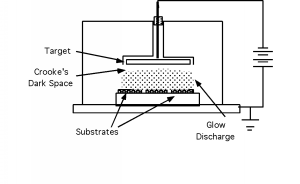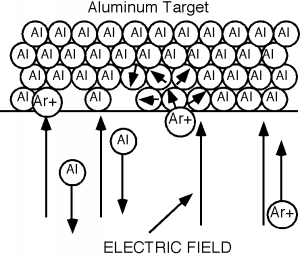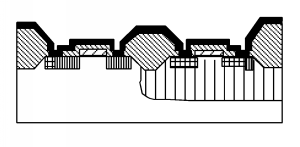4.8: Applying Metal/Sputtering
- Page ID
- 88552
We now put the wafer in a sputter deposition system. In the sputter system, we coat the entire surface of the wafer with a conductor. An aluminum-silicon alloy is usually used, although other metals are employed as well.
A sputtering system is shown schematically in Figure \(\PageIndex{1}\). A sputtering system is a vacuum chamber, which after it is pumped out, is re-filled with a low-pressure argon gas. A high voltage ionizes the gas, and creates what is known as the Crookes dark space near the cathode, which in our case consists of a metal target made out of the metal we want to deposit. Almost all of the potential of the high-voltage supply appears across the dark space. (The glow discharge consists of argon ions and electrons which have been stripped off of them. Since there are about equal number of ions and electrons, the net charge density is about zero, and hence by Gauss's law, so is the field.)

Figure \(\PageIndex{1}\): Sputtering apparatus

The electric field accelerates the argon atoms which slam into the aluminum target. There is an exchange of momentum, and an aluminum atom is ejected from the target (Figure \(\PageIndex{2}\)) and heads to the silicon wafer, where it sticks, and builds up a metal film (Figure \(\PageIndex{3}\)).


If you look at Figure \(\PageIndex{3}\), you will note that we have seemingly done something pretty stupid. We have wired all of the elements of our CMOS inverter together! Ah, but all is not lost. We can do one more photolithographic step, and pattern and etch the aluminum, so we only have it where we need it. This is shown in Figure \(\PageIndex{4}\).



